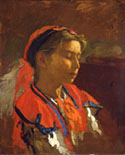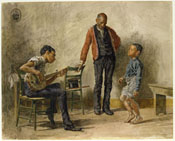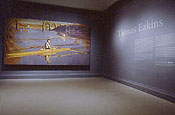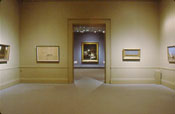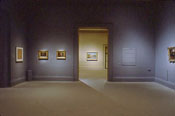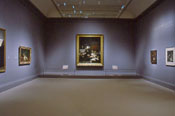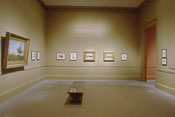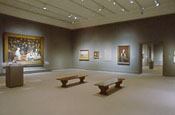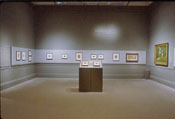The browser will either open the file, download it, or display a dialog.
|
"Thomas Eakins: American Realist" Darrel Sewell, et al. |
||||||||||||||||||||||||||||||||||||||||||||||||||||||||||||||||||||||||
|
Philadelphia painter Thomas Eakins (1844–1916), considered by many to be the paragon of American realism, was the subject of a major retrospective exhibition in 2001–2002 organized by the Philadelphia Museum of Art, with additional venues at the Musée d'Orsay in Paris and the Metropolitan Museum of Art in New York. Known primarily for sober, direct portraits as well as genre scenes executed with scientific precision and set in his native Philadelphia, Eakins struggled to gain respect during his lifetime, but has since attained posthumous recognition as a canonical figure, one of the few American "old masters" to garner international attention. Indeed, his struggles—punctuated by his scandalous ouster from the Pennsylvania Academy of the Fine Arts in 1886—had much to do with his efforts to institute in America the sort of European academic training that he encountered in Paris as a student at the École des Beaux-Arts during the 1860s. |
|||||||||||||||||||||||||||||||||||||||||||||||||||||||||||||||||||||||||
| The large installations in Philadelphia and New York included well over 150 works in several media—oil paintings, watercolors, drawings, sculpture, and photographs—all by Eakins except for a statuette of him by his student Samuel Murray and a handful of difficult-to-attribute photographs taken by members of his immediate circle.1 As the first Eakins retrospective held since the discovery in 1985 of Charles Bregler's private collection of works by the artist, the exhibition truly was unprecedented in its scope and range of materials, especially in the area of photography. In addition to featuring classic Eakins oil paintings such as The Gross Clinic of 1875, various versions of William Rush Carving His Allegorical Figure of the Schuylkill River (1877–1908), and late portraits like Professor Henry A. Rowland of 1897, the exhibition included multiple galleries consisting largely of his photographs. Many of these photographs were displayed adjacent to the paintings for which they served as preparatory studies, some having functioned as projected compositional templates traced onto canvases by Eakins during the 1870s and 1880s. The latter technique, which Eakins probably learned in Paris and which he concealed during his lifetime, was revealed here for the first time and proved to be something of a revelation about his working method. Overall, the exhibition thus offered an immensely valuable and historic opportunity to survey the artist's wide-ranging oeuvre, with special attention paid to matters of artistic process.2 | |||||||||||||||||||||||||||||||||||||||||||||||||||||||||||||||||||||||||
| The exhibition was accompanied by a suitably colossal catalogue, sumptuously illustrated with color plates and containing essays by Darrel Sewell, Marc Simpson, and several other scholars recounting the trajectory of Eakins's technical and stylistic development decade by decade. In that respect, the catalogue mirrored the chronological layout of the exhibition while providing considerable supplementary information, including more details concerning the revelation of Eakins's secret photographic tracings. Aside from the latter news, the catalogue—as well as the exhibition—concentrated on providing a splendidly encyclopedic re-telling of established facts about Eakins's career. In terms of sheer volume of works and information, the occasion constituted an extravaganza for anyone interested in the artist. | |||||||||||||||||||||||||||||||||||||||||||||||||||||||||||||||||||||||||
| As with all encyclopedic extravaganzas, however, the abundance of the show and the book masked significant omissions, disjunctions, and methodological biases. Much recent revisionist scholarship on the artist was entirely ignored, except in a few perfunctory footnotes buried at the back of the catalogue. This point has been made already by David Lubin, but I would go a step further to suggest that the Eakins spectacle subtly reasserted, or reconstituted a version of, older nativist discourse on the artist.3 American cultural nativism, epitomized for example in the virulently xenophobic art criticism of Thomas Craven during the protectionist 1930s, had its kinder, gentler manifestation at the time in the writings of Lloyd Goodrich, who produced the first monograph on Eakins in 1933 and a later expanded version in 1982. In the 1933 monograph, Goodrich opined that "In spite of his training in France, as soon as [Eakins] returned to this country he had begun painting native subjects, in a style entirely his own. ... Most of the leading tendencies of French art passed Eakins by completely; impressionism, the cult of the exotic and Oriental, the return to the primitive, the increasing subjectivism, the decorative bent, the trends towards abstraction, the restless search for new forms and colors."4 While true to a point, Goodrich's view of Eakins increasingly has been modified in recent years as more and more evidence has surfaced indicating the artist's enduring admiration for his teacher Jean-Léon Gérôme and other European painters.5 Regardless of such modifications, though, the ghost of Goodrich seemed to haunt the recent exhibition, which was structured to include no comparative works by Gérôme or any other European artist for that matter. Instead, the emphatically monographic exhibition presented Eakins as deeply "rooted" in Philadelphia and therefore distinctly American, except for a respectable dose of inspiration from Velázquez.6 Consequently, Eakins seemed cleansed entirely of contemporary foreign influence and internationalism, despite his French training. | |||||||||||||||||||||||||||||||||||||||||||||||||||||||||||||||||||||||||
|
|
|||||||||||||||||||||||||||||||||||||||||||||||||||||||||||||||||||||||||
| Viewed broadly in this context, foreign influence might be said to encompass not only the stylistic and conceptual inspiration Eakins drew from contemporary French painters like his beloved master Gérôme, but also "imported" models of critical historical interpretation that have redefined academic art history during the past two decades. Notwithstanding the impressive scale and volume of information presented under the aegis of the Eakins exhibition, none of it emulated the international, poststructural ambition of Michael Fried's Realism, Writing, Disfiguration: On Thomas Eakins and Stephen Crane (1987) or the scholarship of his recent postcolonial successors. In other words, what was missing from the Eakins exhibition, besides a substantive acknowledgement of Gérôme, were the influences of those other Frenchmen—namely Derrida, Foucault, Lacan, Deleuze, and their contemporary offspring—whose interpretive methods have done much to reshape intellectual inquiry about Eakins and the humanities generally since the 1970s. Gérôme and Derrida are strange bedfellows to be sure, but their dual absence from the exhibition's interpretive method revealed a consistent underlying logic, one eschewing "exotic" objects and perspectives à la Goodrich. Such logic coincides uncannily, and perhaps not entirely fortuitously, with the sort of nationalist and unilateralist discourse evident elsewhere in American culture lately. The Eakins exhibition lived up to its billing as a "retrospective" in more ways than one, by turning back the interpretive clock to a point before the influx of foreign intellectual influence in the United States, when a peculiarly native version of modernism prevailed in the field of American art history. | |||||||||||||||||||||||||||||||||||||||||||||||||||||||||||||||||||||||||
| Upon entering the exhibition (at both American venues), I immediately was struck by what was absent. The first gallery surrounded the viewer with a selection of Eakins's outdoor sporting pictures of the early 1870s, including several of his signature rowing pictures—The Champion Single Sculls (Max Schmitt in a Single Scull) of 1871 and The Pair-Oared Shell of 1872, among others. Nice though it was to see these superb and familiar works right away, I had expected such a large retrospective to open with at least a few of the artist's juvenile and early art-school efforts, not pictures produced when he was nearly thirty years old. By espousing the view that an artist's early life matters, I risk sounding quaintly old-fashioned in my own way for privileging biography and authorial development. Yet such an emphatically monographic (as opposed to historically contextual) exhibition as "Thomas Eakins" would seem to presuppose the importance of artistic biography as a valid interpretive frame and therefore invite scrutiny on such grounds. Born in Philadelphia in 1844, Eakins by 1871 had studied drawing at Central High and the Pennsylvania Academy of the Fine Arts (1857–63), anatomy at Jefferson Medical College and in Paris (1865–69), and painting and sculpture at the École des Beaux-Arts under Gérôme, Augustin-Alexandre Dumont, and Léon Bonnat (1866–69). By 1871, in other words, Eakins already had produced a small, but significant, body of student works that arguably foreshadowed many of his later artistic techniques, motifs, and metaphorical preoccupations. None of these was included in the exhibition. | |||||||||||||||||||||||||||||||||||||||||||||||||||||||||||||||||||||||||
| For example, one surprising absence was the Metropolitan's own Carmelita Requeña of 1869, a beautiful Couturesque study of a young Gypsy girl that Eakins encountered in Seville during his last months in Europe (fig. 1). Represented in a state of quiet absorption with downcast eyes, using loose brushstrokes and a rich "Spanish" palette of golden brown, yellow, white, and vermilion, Carmelita prefigures subjects in later "psychological" portraits by Eakins such as Portrait of Amelia C. Van Buren of about 1891, Portrait of Maud Cook of 1895, and The Thinker (Portrait of Louis N. Kenton) of 1900. All three of the latter works did appear in the exhibition, in the final galleries dedicated to Eakins's late portraiture. A similar point can be made about another interesting early study by Eakins entitled A Negress of 1867–69, now owned by the Fine Arts Museums of San Francisco. Probably one of Eakins's earliest forays in oil, this work negotiates psychological absorption and emotional resignation through the downcast glance and nude body of a turbaned woman whose coral earring and dark skin relate the work directly to Frédéric Bazille's contemporary experiments with Orientalism in the aftermath of Manet's Olympia.7 Then there is—or rather, was not—Eakins's first tableau, or multi-figure composition, a work of 1870 entitled A Street Scene in Seville (Collection of Erving and Joyce Wolf), painted in Spain around the same time as Carmelita Requeña. The Street Scene shows Carmelita dancing to music played by her parents, wearing a bright red dress that contributes dramatically to this visual compendium of bohemian "Spanishness." In a work exemplifying Eakins's engagement with the contemporary international discourse of picturesque ethnography, Carmelita's pose here recalls that of Anita Montez in Manet's The Spanish Ballet (1862, Phillips Collection, Washington, D.C.) as well as the central figure in Gérôme's Dance of the Almah (1863, Dayton Art Institute, Dayton, Ohio).8 | |||||||||||||||||||||||||||||||||||||||||||||||||||||||||||||||||||||||||
|
|
|||||||||||||||||||||||||||||||||||||||||||||||||||||||||||||||||||||||||
| Such omissions from the Eakins exhibition had the effect of presenting the rowing and other sporting pictures of the early 1870s as works that signaled the real beginning of his artistic activity, as if his return from Europe to native soil marked his birth as a painter. Although the omissions may have seemed justified on practical grounds, they nevertheless highlight a significant disjunction between the exhibition and the catalogue, which includes two sizable essays on Eakins's juvenilia and student works executed abroad.9 Incidentally, by stepping directly into a room filled with images containing views of the artist's hometown Philadelphia—notably its recreational rather than burgeoning industrial side (which the artist never painted)—the viewer naturally was led to equate Eakins with his native soil and water. Even given the monographic parameters of the exhibition, why not include a picture or two by Eakins's influential master Gérôme, such as the hugely successful Nile river scene entitled The Prisoner of 1861 (Musée des Beaux-Arts, Nantes)? Often cited in relation to Eakins's rowing pictures, The Prisoner would have offered a valuable opportunity for viewers to observe similarities and differences between teacher and pupil. To be sure, the absence of such comparative works probably has to do with concerns about cost, scope, and security, which were legitimate and undoubtedly pressing issues for museums (especially the Metropolitan) after 11 September 2001. | |||||||||||||||||||||||||||||||||||||||||||||||||||||||||||||||||||||||||
| And yet, the critical business of America must go on, as President Bush has said. In that spirit, it is worth noting that the exhibition's avoidance of Eakins's European artistic sources and contacts paralleled an analogous evasion of thorny cultural and historical issues on the home front. Reading the exhibition labels, visitors would hardly have known that Eakins lived through the Civil War, Reconstruction, Jim Crow, the rise of the modern labor and feminist movements, the Progressive Era, or any number of other defining chapters of American history. For example, the wall label in Gallery 3 for Eakins's 1878 watercolor The Dancing Lesson (Negro Boy Dancing), showing a group of minstrels rehearsing, gave no inkling of how the work might have broached the predicament of African Americans after Reconstruction, which collapsed only a year before with the Compromise of 1877 (fig. 2). The Compromise, an infamous political bargain to resolve the nation's first notorious general election standoff in 1876, entailed recalling federal troops from the South, bringing an end to Reconstruction civil rights gains for blacks in exchange for the requisite votes to elect President Rutherford B. Hayes, a Republican. | |||||||||||||||||||||||||||||||||||||||||||||||||||||||||||||||||||||||||
| Is any of this pictured in Eakins's watercolor? Not per se, but by deliberately reproducing a famous portrait of Abraham Lincoln in the background of the picture, the artist clearly asserted his affiliation to the Republican Party and its legacy of emancipation. Such political-historical connections seem unavoidable when we recall that the Republican-dominated Union League Club of Philadelphia hired Eakins to paint Hayes's portrait in 1877.10 Produced in 1878, The Dancing Lesson encoded some of the very ambivalence that marked Republican racial politics at that moment. On the one hand, the watercolor (originally entitled Study of Negroes by Eakins) touted the "natural" creativity and post-emancipation freedom of African American minstrels by drawing upon picturesque precedents like those in his own Street Scene in Seville, Gérôme's Pifferari pictures, and other European peasant imagery. At the same time, the watercolor subtly bespoke a lingering Euro-American fascination with, and longing for, old-time slave imagery well after the Civil War, as suggested by the critical response of Eakins's friend Earl Shinn to the work in a contemporary review published in The Nation. Shinn praised the work for combining a "quiet intensity" with "goblin humor" in representing "the comedy of plantation life."11 Despite the common art-historical refrain that Eakins's realism was uncompromising, The Dancing Lesson actually mirrored the forces of political compromise governing Republican thinking of the period, for it left African Americans in a state of limbo between emancipation and full citizenship, no longer slaves but still on the "plantation." Here and elsewhere, the Eakins exhibition remained silent about such wider connections between art and history, concentrating instead—in high modernist fashion—on matters of artistic process and technique. Nor did the exhibition mine any of the European prototypes that repeatedly proved so useful to Eakins in addressing domestic issues. Acknowledgment of cultural history occurred only obliquely, and perhaps unintentionally, in the heading for Gallery 3—"Images of History and Modernity"—which aptly described both of the opposing forces within The Dancing Lesson, a work rife with ambivalence and both domestic and international significance.12 | |||||||||||||||||||||||||||||||||||||||||||||||||||||||||||||||||||||||||
| Perhaps it is enough that the Eakins exhibition gave us such a rich opportunity to view so many of his works again and to review so many procedural facts about his artistic career. Indeed, that is the great service so often provided by the museum as an institution in our society—a service that no other institution can adequately offer and one for which it deserves great praise. But in this age of global networking and instantaneous communication, the Eakins exhibition seemed strangely disconnected from the world outside the museum and outside America. For in presenting the artist as so deeply rooted in his native soil, to the exclusion of other sources of inspiration, it gave an impression that Eakins worked in a historical vacuum—the proverbial boy in a bubble, who never, in a sense, left home. | |||||||||||||||||||||||||||||||||||||||||||||||||||||||||||||||||||||||||
| Alan C. Braddock Assistant Professor Department of Fine Arts Syracuse University |
|||||||||||||||||||||||||||||||||||||||||||||||||||||||||||||||||||||||||
|
2. For a detailed discussion of Eakins's tracing of projected photographs, see Mark Tucker and Nica Gutman's essay in the accompanying catalogue, "Photographs and the Making of Paintings," pp. 225–38. 3. Lubin 2002, pp. 515–16, cites the writings of Martin Berger, Whitney Davis, Jennifer Doyle, Alan Braddock, Judith Fryer, Bridget Goodbody, Randall Griffin, Michael Hatt, Marcia Pointon, and Eric Rosenberg. 4. Lloyd Goodrich, Thomas Eakins: His Life and Work, exh. cat., Whitney Museum of American Art, New York (New York: Whitney Museum of American Art, 1933), 1933, p. 154. In addition to offering a very different reading of Eakins's work, my dissertation points out that Goodrich unwittingly acknowledged the very influences and traits that such statements deny. See Alan C. Braddock, "Displacing Orientalism: Thomas Eakins and Ethnographic Modernity," Ph.D. diss., University of Delaware, 2002, pp. 9–10. 5. Gerald M. Ackerman, "Thomas Eakins and His Parisian Masters Gérôme and Bonnat," Gazette des Beaux-Arts 73 (April 1969), pp. 235–56; H. Barbara Weinberg, The American Pupils of Jean-Léon Gérôme, exh. cat., Amon Carter Museum, Fort Worth (Fort Worth: Amon Carter Museum), 1984; H. Barbara Weinberg, The Lure of Paris: American Artists at the École des Beaux-Arts, New York: Abbeville, 1991; Kathleen A. Foster, Thomas Eakins Rediscovered: Charles Bregler's Thomas Eakins Collection at the Pennsylvania Academy of the Fine Arts, Philadelphia: Pennsylvania Academy of the Fine Arts and New Haven: Yale University Press, 1997; Alan C. Braddock, "Eakins, Race, and Ethnographic Ambivalence," Winterthur Portfolio 33 (Summer–Fall 1998), pp. 135–61; Braddock 2002. 6. For a reference to Eakins's Philadelphia "roots," now a cliché in writing about the artist, see the corporate "Sponsor's Statement" in the present catalogue (p. v) by Dennis Alter, Chairman and CEO of Advanta: "Thomas Eakins was a world-class artist whose Philadelphia roots and influence were woven throughout his works and his teachings. ... At Advanta we, too, strive to truly understand our customers and develop services to meet their unique needs. Advanta's roots are also deeply connected to Philadelphia." 7. I have proposed elsewhere (Braddock 2002, pp. 96–102) that she is, in fact, the very same professional model who posed for Bazille's La Toilette and two pictures entitled Négresse aux Pivoines, all painted around 1870. 8. For discussion of these and other visual connections between the work of Eakins and European painters, see Braddock 2002, passim. See also Braddock 1998, pp. 135–46. 9. Amy Werbel, "Eakins's Early Years," pp. 1–12; H. Barbara Weinberg, "Studies in Paris and Spain," pp. 13–26. 10. Gordon Hendricks, "The Eakins Portrait of Rutherford B. Hayes," American Art Journal 1 (Spring 1969), pp. 104–14. 11. Earl Shinn, "Fine Arts. Eleventh Exhibition of the Water-Color Society. II," The Nation 26 (28 February 1878), pp. 156–57. 12. Marc Simpson, in his essay, "Eakins's Vision of the Past and the Building of a Reputation," briefly mentions "the watercolor's implicit nostalgia, a sentiment here evoked by race and class rather than chronology" (p. 213). For further discussion of this watercolor and these historical issues, see Braddock 1998 and Braddock 2002, pp. 194–228. |
|||||||||||||||||||||||||||||||||||||||||||||||||||||||||||||||||||||||||
|
|||||||||||||||||||||||||||||||||||||||||||||||||||||||||||||||||||||||||


